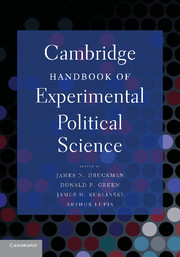Book contents
- Frontmatter
- Contents
- List of Tables
- List of Figures
- Contributors
- Acknowledgments
- INTRODUCTION
- PART I DESIGNING EXPERIMENTS
- PART II THE DEVELOPMENT OF EXPERIMENTS IN POLITICAL SCIENCE
- 6 Laboratory Experiments in Political Science
- 7 Experiments and Game Theory's Value to Political Science
- 8 The Logic and Design of the Survey Experiment
- 9 Field Experiments in Political Science
- PART III DECISION MAKING
- PART IV VOTE CHOICE, CANDIDATE EVALUATIONS, AND TURNOUT
- PART V INTERPERSONAL RELATIONS
- PART VI IDENTITY, ETHNICITY, AND POLITICS
- PART VII INSTITUTIONS AND BEHAVIOR
- PART VIII ELITE BARGAINING
- PART IX ADVANCED EXPERIMENTAL METHODS
- AFTERWORD
- Name Index
- Subject Index
- References
6 - Laboratory Experiments in Political Science
Published online by Cambridge University Press: 05 June 2012
- Frontmatter
- Contents
- List of Tables
- List of Figures
- Contributors
- Acknowledgments
- INTRODUCTION
- PART I DESIGNING EXPERIMENTS
- PART II THE DEVELOPMENT OF EXPERIMENTS IN POLITICAL SCIENCE
- 6 Laboratory Experiments in Political Science
- 7 Experiments and Game Theory's Value to Political Science
- 8 The Logic and Design of the Survey Experiment
- 9 Field Experiments in Political Science
- PART III DECISION MAKING
- PART IV VOTE CHOICE, CANDIDATE EVALUATIONS, AND TURNOUT
- PART V INTERPERSONAL RELATIONS
- PART VI IDENTITY, ETHNICITY, AND POLITICS
- PART VII INSTITUTIONS AND BEHAVIOR
- PART VIII ELITE BARGAINING
- PART IX ADVANCED EXPERIMENTAL METHODS
- AFTERWORD
- Name Index
- Subject Index
- References
Summary
Until the mid-twentieth century, the discipline of political science was primarily qualitative – philosophical, descriptive, legalistic, and typically reliant on case studies that failed to probe causation in any measurable way. The word “science” was not entirely apt.
In the 1950s, the discipline was transformed by the behavioral revolution, spearheaded by advocates of a more social scientific, empirical approach. Even though experimentation was the sine qua non of research in the hard sciences and in psychology, the method remained a mere curiosity among political scientists. For behavioralists interested in individual-level political behavior, survey research was the methodology of choice on the grounds that experimentation could not be used to investigate real-world politics (for more detailed accounts of the history of experimental methods in political science, see Bositis and Steinel 1987; Kinder and Palfrey 1993; Green and Gerber 2003). The consensus view was that laboratory settings were too artificial and that experimental subjects were too unrepresentative of any meaningful target population for experimental studies to be valid. Furthermore, many political scientists viewed experiments – which typically necessitate the deception of research subjects – as an inherently unethical methodology.
The bias against experimentation began to weaken in the 1970s when the emerging field of political psychology attracted a new constituency for interdisciplinary research. Laboratory experiments gradually acquired the aura of legitimacy for a small band of scholars working at the intersection of the two disciplines.
- Type
- Chapter
- Information
- Cambridge Handbook of Experimental Political Science , pp. 73 - 88Publisher: Cambridge University PressPrint publication year: 2011
References
- 35
- Cited by



